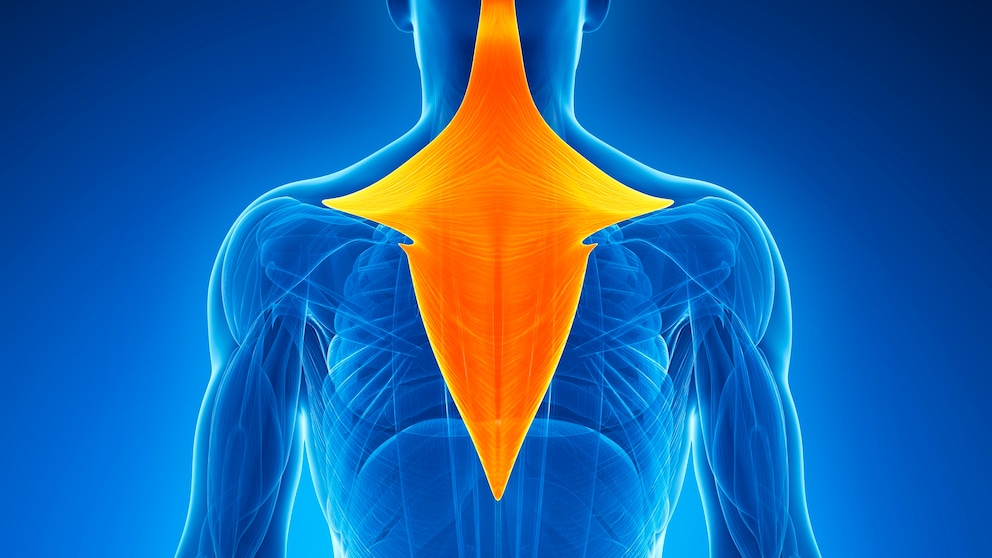January 22, 2025, 4:47 pm | Read time: 4 minutes
The trapezius muscle is part of the shoulder girdle musculature, and all its parts play an important role in the movement and stabilization of the shoulder blades. FITBOOK describes the anatomy of the trapezius muscle and its functions and presents exercises for strengthening and stretching.
The trapezius owes its name to its trapezoidal appearance. The muscle extends over a large area of the upper back and is divided into three parts, each of which enables different shoulder movements. Find out more about the anatomy, functions, and ways to strengthen and stretch the trapezius muscle below.
Overview
Anatomy of the Trapezius Muscle
As already mentioned, the trapezius consists of three parts: an upper descending part (pars descendens), a transverse part (pars transversa), and a lower, ascending part (pars ascendens). Viewed as a whole, the origins of the trapezius muscle extend from the back of the head down to the thoracic vertebrae. It also has different attachments.
Origin
- Pars descendens: Originates at the occipital protuberance (occipital bone) and the spinous processes of the 1st to 6th cervical vertebrae.
- Pars transversa: Originates from the spinous process of the 7th cervical vertebra and the spinous processes of the 1st to 3rd thoracic vertebrae.
- Pars ascendens: Originates at the spinous processes of the 3rd to 12th thoracic vertebrae.
Attachment
- Pars descendens: on the outer third of the collarbone (clavicle) and at shoulder level (acromion)
- Pars transversa: on the outer third of the scapula (spina scapulae)
- Pars ascendens: on the inner third of the scapula’s spine
Functions of the Trapezius Muscle
The trapezius muscle has different functions depending on its part. Overall, however, the muscle plays an important role in holding the shoulder blades in place.
- Pars descendens (upper part): Lifts the shoulder blades (elevation), turns the shoulder blade outwards, and can tilt or turn the head.
- Pars transversa (middle part): Draws the shoulder blades together medial to the spine (retraction) and is important for correct positioning of the shoulder girdle.
- Pars ascendens (lower part): Lowers the shoulder blades (depression).
Special Features of the Trapezius Muscle
The pars descendens and pars ascendens act both as synergists and antagonists to each other, depending on which movements the shoulder girdle performs. Another special feature is that the pars descendens tends to shorten, which can lead to painful muscle tension in the shoulder/neck area, especially in people who sit a lot in everyday life. This can be counteracted by stretching this area.
Pars transversa and pars ascendens, on the other hand, tend to weaken. The former, in particular, can also cause typical shoulder pain between the shoulder blades – strengthening can help here.
Exercises for the Trapezius Muscle
With Your Own Body Weight
Admittedly, finding a bodyweight exercise to effectively train the trapezius muscle can be challenging. Here is one possibility:
Elbow Press in Supine Position
Here’s how:
- Lie on your back on the floor, spread your arms out to the side, then stretch your forearms or hands towards the ceiling.
- Press your elbows into the floor so that your upper back is slightly raised.
- Hold the tension and lower back down in a controlled manner.
With Equipment
Butterfly Reverse
The butterfly reverse is often performed on the same machine used for chest butterfly exercises. However, you then sit with your stomach against the backrest and adjust the levers or handles so that they are no longer positioned to the side but in front of your chest. The seat should be adjusted so that the buttocks are slightly above knee height and the hands or arms are positioned slightly below the shoulder joint.
With Dumbbells
Barbell Row with Wide Grip
- Grip the barbell with a wide grip.
- Bend your upper body forward.
- Bring the barbell towards your chest while pulling your shoulder blades together.
- Slowly lower the barbell again.
The upper body remains bent forward during the entire movement.
With Cable Pull
Cable Crossover
This cable pulley exercise trains the trapezius muscle effectively by intensifying the movements of the shoulder blades. Ideally, you should use two cable pulleys.
Here’s how it works:
- Stand between the two cable pulleys and take the opposite one-handed grips in each hand.
- Then, pull the cable outwards from the crossover position so that the shoulder blades contract.
- Slowly return to the starting crossover position.

Shoulder muscles Deltoid muscle – anatomy, function and exercises

She shows her workouts on social media Singer Lizzo wants to get fitter with this workout

Actor Paul Mescal “Gladiator II” star: “I ate 5,000 calories a day”
Stretching Exercises for the Trapezius Muscle
The following options are available for stretching the trapezius muscle:
- Self-hug: This involves bringing your hands to the opposite shoulder blades or shoulders and pulling them forward.
- Hunch over and stretch out your arms: Actively stretching your arms forward stretches the trapezius well.

